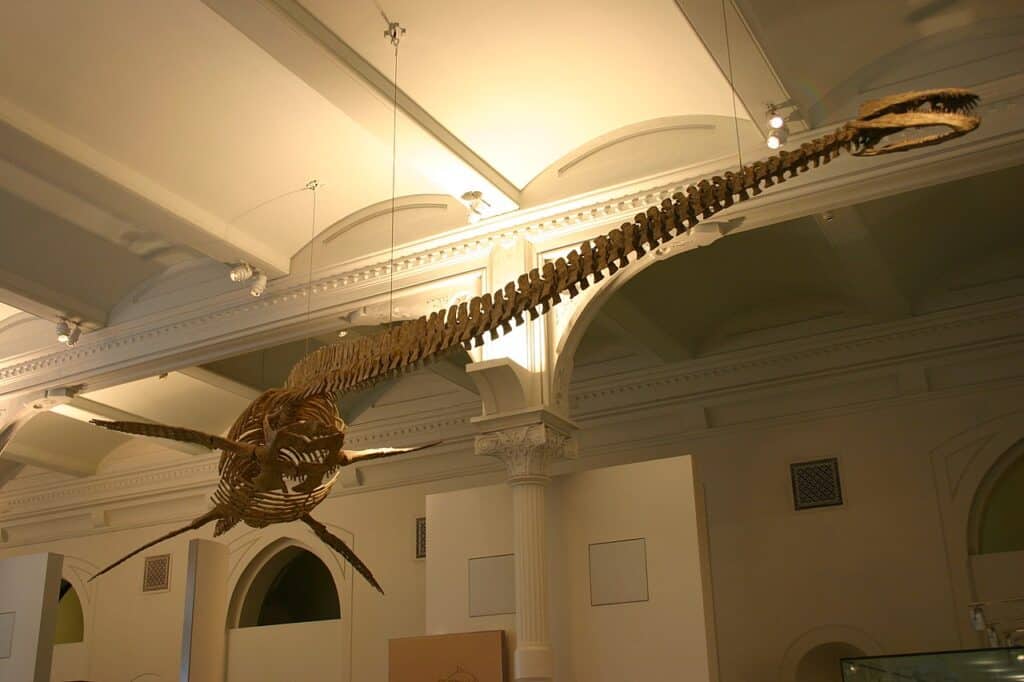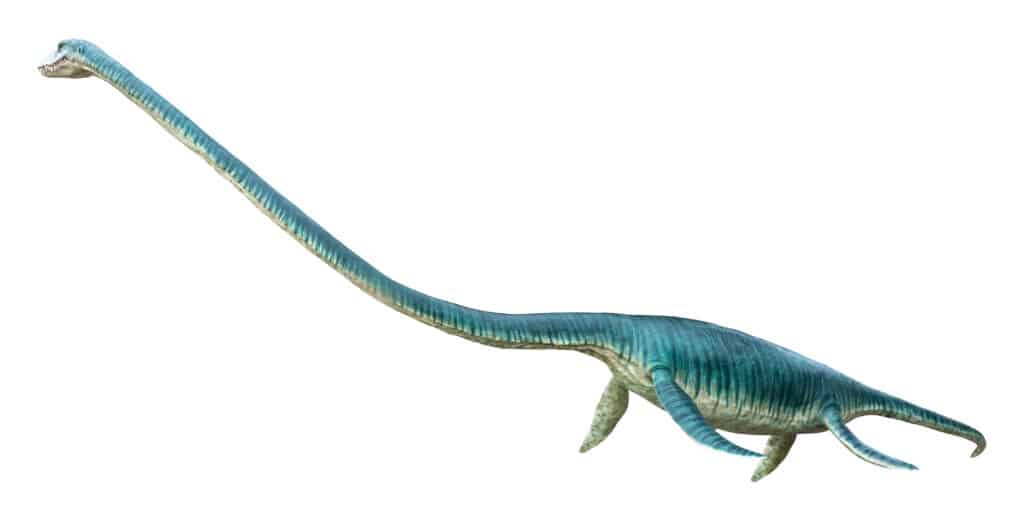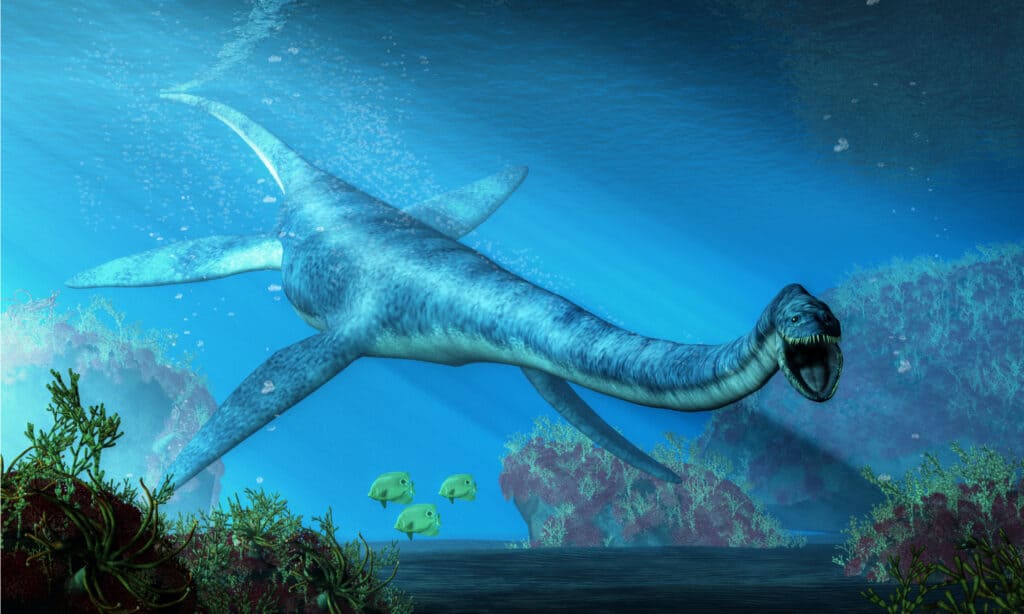The ocean is home to some of the craziest creatures known to man (and plenty that aren’t). Although humans have only been around for a few hundred thousand years, we can look back in time through the fossil record. One of the wildest creatures to have ever lived on earth had a neck was so awe-inspiring that the people who found it named it “Sea Lord”. Let’s learn all about this massive creature of the deep!
The Ancient Sea Lord that Patrolled the Deep

Ryan Somma / CC BY-SA 2.0 – License
Thalassomedon was one of the largest elasmosaurids that lived 95 million years ago.
What would cause someone to find a fossil and nickname it the “sea lord”? How about a 36-foot creature with a massive neck that could have weighed up to five tons! Thalassomedon literally translates to sea lord in Greek (thalassa, “sea” and Greek, medon, “lord” or “ruler”). It was first discovered and officially named in 1943, although it was around a very long time before that.
Thalassomedon belonged to a group of reptiles known as elasmosaurids. Elasmosaurids were a genus of plesiosaurs that were technically not dinosaurs, although you wouldn’t know it from the way they look. They were large, marine reptiles that breathed air and had extremely long necks.
What did Thalassomedon Look Like?
Thalassomedon was a plesiosaur, a group of creatures characterized by their long necks, small heads, and big bodies. Although these elasmosaurids lived in the water, they looked quite similar to the well-known Brachiosaurus and Brontosaurus. Whereas Brachiosaurus and Brontosaurus had large legs, however, Thalassomedon and the other elasmosaurids had flippers. Additionally, the bodies of elasmosaurids were much more streamlined and better suited for a life of swimming.
Aside from it’s body shape, Thalassomedon had one heck of a neck. Using fossil evidence, scientists estimate that the neck of Thalassomedon was around 20 feet long – well over half the entire length of the body. The neck of Thalassomedon had 62 vertebrae, which is significantly more than the modern-day giraffe has!
How Big was Thalassomedon?

YuRi Photolife/Shutterstock.com
Thalassomedon was one of the largest elasmosaurids, although it wasn’t the biggest. The range that scientists place Thalassomedon within was likely between 35 and 38 feet long. Additionally, it would have weighed between 2.8 and 4.9 tons, depending on estimates that scientists use to calculate them.
Overall, Thalassomedon was truly huge. Of the elasmosaurids, only a rare few species are the same size or larger. For the time period that Thalassomedon lived in, however, being big was essential if you wanted to survive since there were so many massive reptiles alive during the time.
One interesting fact about Thalassomedon, as well as the other elasmosaurids, is that their necks were probably rigid. When we think of long-necked sea creatures, we usually envision a serpentine neck, but that probably wasn’t the case. The lack of mobility in the neck can be seen from the small vertebrae movement allowed, as well as the way the bones all fit together. In fact, Thalassomedon probably wouldn’t have been able to fit anything besides its head out of the water.
Thalassomedon‘s Stomach Stones

Daniel Eskridge/Shutterstock.com
One of the interesting things about Thalassomedon is that researchers found its fossils with numerous stones inside where its stomach was. Although there isn’t a definite answer as to why Thalassomedon was eating rocks, some of the most popular theories consider that the rocks were used as a ballast to help it stay under the water or that the stones were used to grind food down once ingested.
Interestingly, there is a group of animals today that swallow stones in order to aid in digestion: birds! Certain species of birds will often swallow stones in order to fill their gizzards. Then, once they contract their gizzards, the stones crush the food (usually seeds) into something more digestible. If birds are any example of how dinosaurs used to live, it is possible that Thalassomedon was doing something similar.
When and where did Thalassomedon Live?
Thalassomedon lived during the Late Cretaceous period, the era before the extinction event that wiped out the dinosaurs. Fossil evidence shows that they likely lived around 95 million years ago during the time of many other elasmosaurids.
Although Thalassomedon was a marine animal, it mostly lived in waters around what is now North America. During that time, the regions where the fossils were discovered were underwater. Thalassomedon would have spent its entire life in the water and was a carnivore. Thankfully, humans weren’t around when Thalassomedon was!
Up Next:
- Meet The Ancient Sea Reptile With A Comically Long Neck
- 9 Dinosaurs With Long Necks
- Top 10 World’s Largest Dinosaurs Ever
The post Meet The ‘Sea Lord’ With The Longest Neck You’ve Ever Seen appeared first on AZ Animals.
from Animal News, Facts, Rankings, and More! - AZ Animals https://ift.tt/OYI6cE4